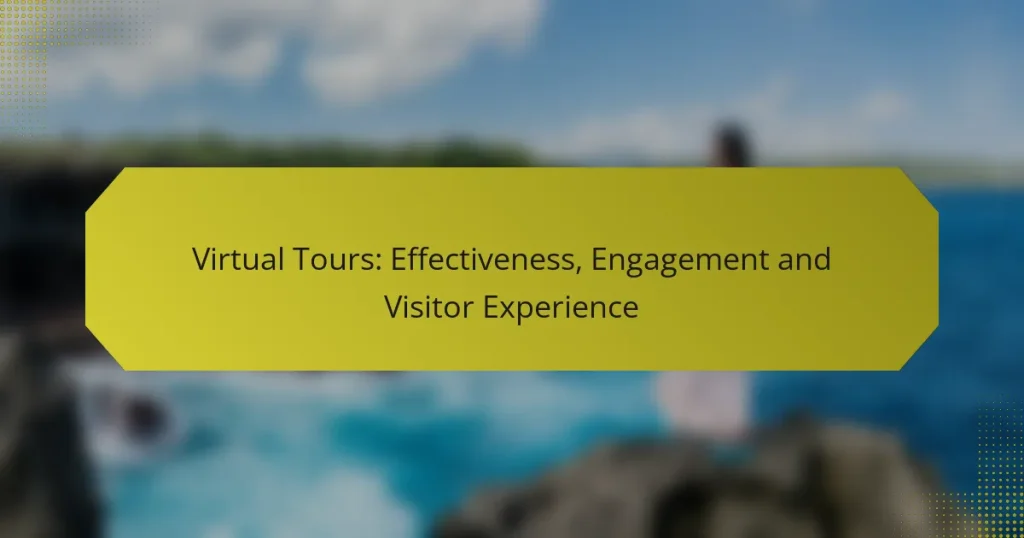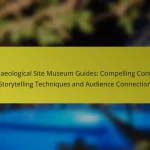Virtual tours have revolutionized the way audiences engage with spaces, offering immersive experiences that captivate and retain interest far beyond traditional methods. By enabling interactive exploration, these tours enhance visitor experiences in settings like museums, allowing users to access exhibits at their own pace and from anywhere. With various platforms available, selecting the right one can further tailor the experience to meet specific needs and preferences.

How effective are virtual tours in enhancing visitor engagement?
Virtual tours significantly enhance visitor engagement by providing immersive experiences that captivate audiences. They allow users to explore spaces interactively, leading to increased interest and participation compared to traditional methods.
Increased interaction rates
Virtual tours promote higher interaction rates as they encourage visitors to explore at their own pace. Users can click on various elements, view additional information, and engage with multimedia content, which keeps them involved longer.
For example, museums that offer virtual tours often see a notable rise in the number of visitors who interact with exhibits, as they can delve deeper into topics of interest through interactive features.
Higher retention of information
Engagement through virtual tours leads to better retention of information. When visitors actively participate in their learning experience, they are more likely to remember what they have seen and learned.
Studies suggest that interactive experiences can improve information retention rates by up to 50% compared to passive viewing. This is particularly beneficial in educational settings where understanding complex concepts is crucial.
Improved visitor satisfaction
Virtual tours often result in higher visitor satisfaction due to their engaging nature. Users appreciate the flexibility to explore and learn on their own terms, which enhances their overall experience.
Feedback from participants frequently highlights the enjoyment of navigating through virtual environments, leading to positive reviews and increased likelihood of recommending the experience to others. This satisfaction can translate into repeat visits or increased support for the hosting organization.
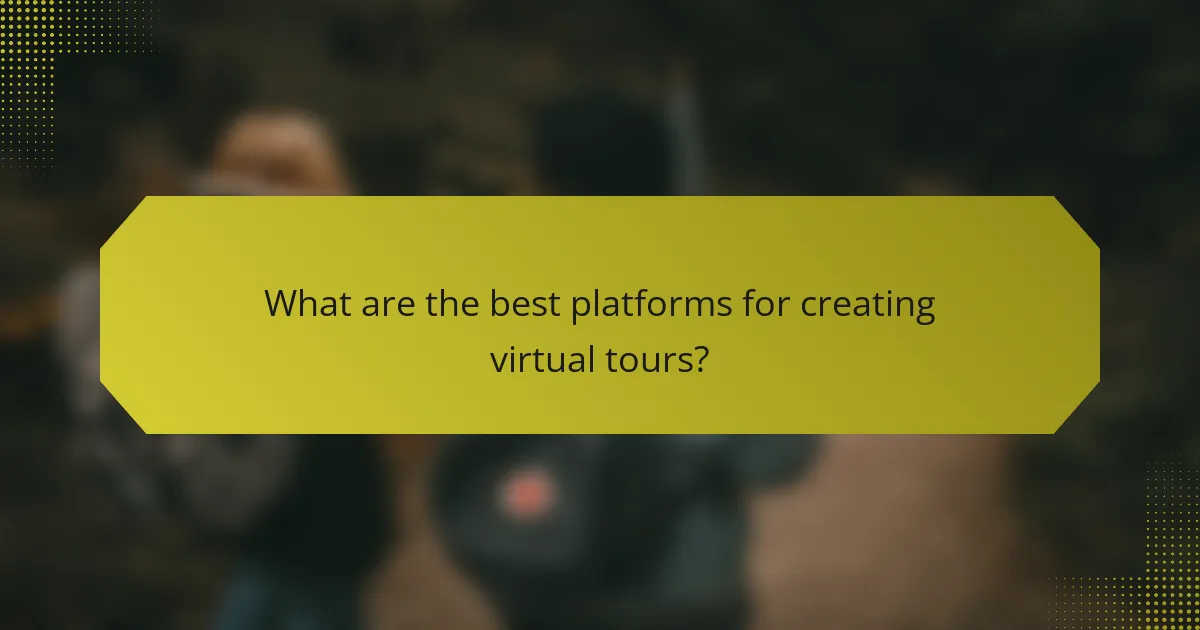
What are the best platforms for creating virtual tours?
Several platforms excel in creating virtual tours, each offering unique features and capabilities. The best choice depends on your specific needs, such as ease of use, customization options, and budget.
Matterport
Matterport is a leading platform known for its high-quality 3D virtual tours. It uses specialized cameras to capture spaces in detail, creating immersive experiences that can be easily navigated by users.
Consider Matterport if you require professional-grade visuals and a user-friendly interface. However, be aware that the initial investment in equipment and subscription fees can be significant, often starting in the low hundreds of USD per month.
Roundme
Roundme offers a straightforward way to create and share virtual tours using panoramic images. Users can upload their 360-degree photos and arrange them into a cohesive tour with interactive hotspots.
This platform is ideal for those looking for a cost-effective solution, as it provides free and paid plans. The free version allows basic features, while paid plans offer advanced customization options, starting at around 10 EUR per month.
Google Tour Creator
Google Tour Creator is a free tool that allows users to build virtual tours using 360-degree images and Google Street View content. It integrates seamlessly with Google Maps, making it easy to share tours online.
This platform is suitable for educators and small businesses looking for a budget-friendly option. However, the customization options are limited compared to other platforms, so it may not meet the needs of users seeking advanced features.
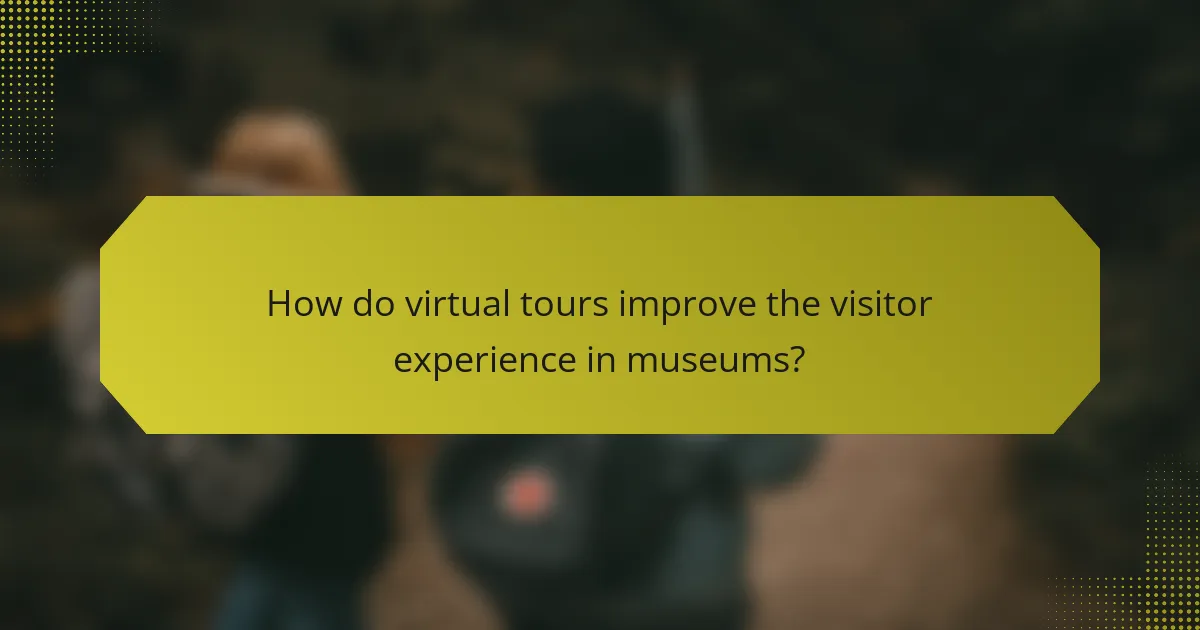
How do virtual tours improve the visitor experience in museums?
Virtual tours enhance the visitor experience in museums by providing immersive and interactive access to exhibits from anywhere. They allow users to explore collections at their own pace, making art and history more accessible and engaging.
Interactive exhibits
Interactive exhibits in virtual tours enable visitors to engage with artifacts and displays in a dynamic way. Users can click on items for detailed information, view 3D models, or even participate in quizzes related to the exhibits. This interactivity fosters a deeper understanding and retention of the material presented.
For instance, a virtual tour of an art museum might allow users to zoom in on brush strokes in a painting or listen to audio commentary from curators. Such features can significantly enhance the educational value of the experience compared to traditional viewing.
Accessibility for remote visitors
Virtual tours significantly improve accessibility for remote visitors, allowing individuals who cannot physically visit museums to enjoy the collections. This is particularly beneficial for those with mobility challenges, geographic limitations, or financial constraints, as they can explore exhibits without travel costs or physical barriers.
Many museums offer free or low-cost virtual tours, making cultural experiences available to a wider audience. By providing multiple languages and subtitles, museums can further enhance accessibility, ensuring that diverse populations can engage with their offerings.
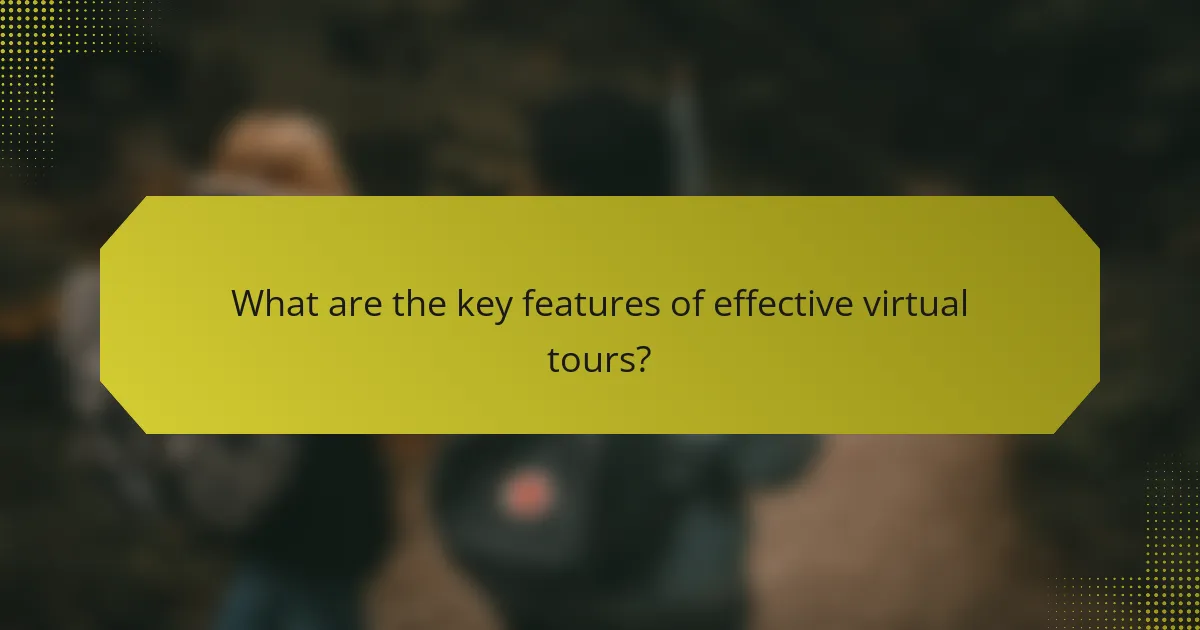
What are the key features of effective virtual tours?
Effective virtual tours combine high-quality visuals, user-friendly navigation, and engaging storytelling elements to create an immersive experience for visitors. These features enhance user engagement and satisfaction, making virtual tours a powerful tool for showcasing locations, products, or services.
High-quality visuals
High-quality visuals are crucial for effective virtual tours as they create an immersive experience that captivates viewers. This includes using high-resolution images, 360-degree views, and video content that accurately represent the space or product being showcased.
To achieve high-quality visuals, invest in professional photography and videography. Ensure that lighting is optimal and that the environment is well-staged to highlight key features. Consider using software that allows for seamless transitions between different views to maintain viewer interest.
User-friendly navigation
User-friendly navigation is essential for ensuring that visitors can easily explore the virtual tour without frustration. Intuitive controls, such as clickable hotspots, arrows, and a clear layout, help guide users through the experience.
When designing navigation, keep in mind the importance of accessibility. Use familiar icons and provide clear instructions. Testing the tour with real users can help identify any navigation issues and improve overall usability.
Engaging storytelling elements
Engaging storytelling elements enhance the virtual tour by providing context and emotional connection. Incorporating narratives, audio guides, or interactive elements can make the experience more memorable and informative.
To create compelling stories, focus on the unique aspects of the location or product. Use anecdotes, historical facts, or testimonials to draw viewers in. Additionally, consider integrating multimedia elements like background music or voiceovers to enrich the storytelling experience.
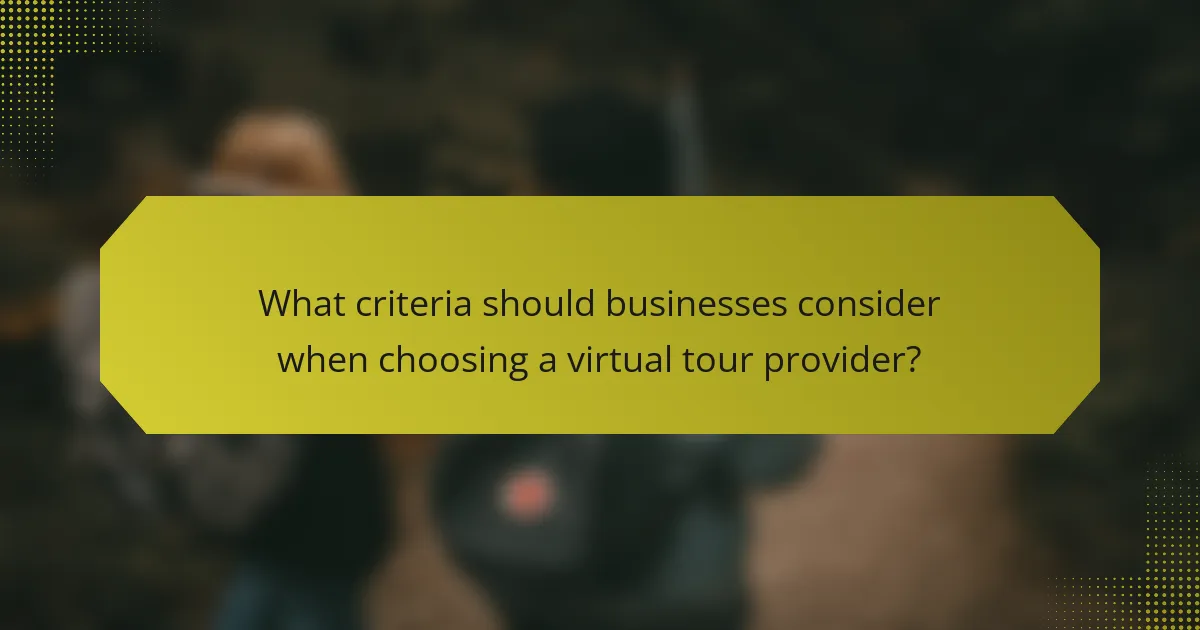
What criteria should businesses consider when choosing a virtual tour provider?
Businesses should evaluate several key criteria when selecting a virtual tour provider, including cost-effectiveness, customization options, and the availability of technical support. These factors can significantly impact the overall quality and success of the virtual tour experience.
Cost-effectiveness
Cost-effectiveness is crucial when choosing a virtual tour provider, as it directly affects your budget and return on investment. Consider providers that offer transparent pricing models, including one-time fees versus subscription plans, to find the best fit for your financial situation.
It’s advisable to compare multiple providers to gauge average costs, which can range from several hundred to several thousand dollars depending on features and complexity. Look for packages that include essential services without hidden fees.
Customization options
Customization options allow businesses to tailor virtual tours to their specific needs and branding. Look for providers that offer flexible features such as personalized branding, interactive elements, and the ability to integrate multimedia content like videos and images.
Assess how easily you can modify the tour’s layout and content. A good provider should allow you to make adjustments without requiring extensive technical knowledge, ensuring that your virtual tour remains relevant and engaging.
Technical support availability
Technical support availability is vital for addressing any issues that may arise during the implementation or use of the virtual tour. Ensure that the provider offers reliable support channels, such as live chat, email, or phone assistance, and check their response times.
Consider the time zones of the support team, especially if your business operates internationally. A provider with 24/7 support can be beneficial for resolving urgent issues quickly, enhancing the overall visitor experience.
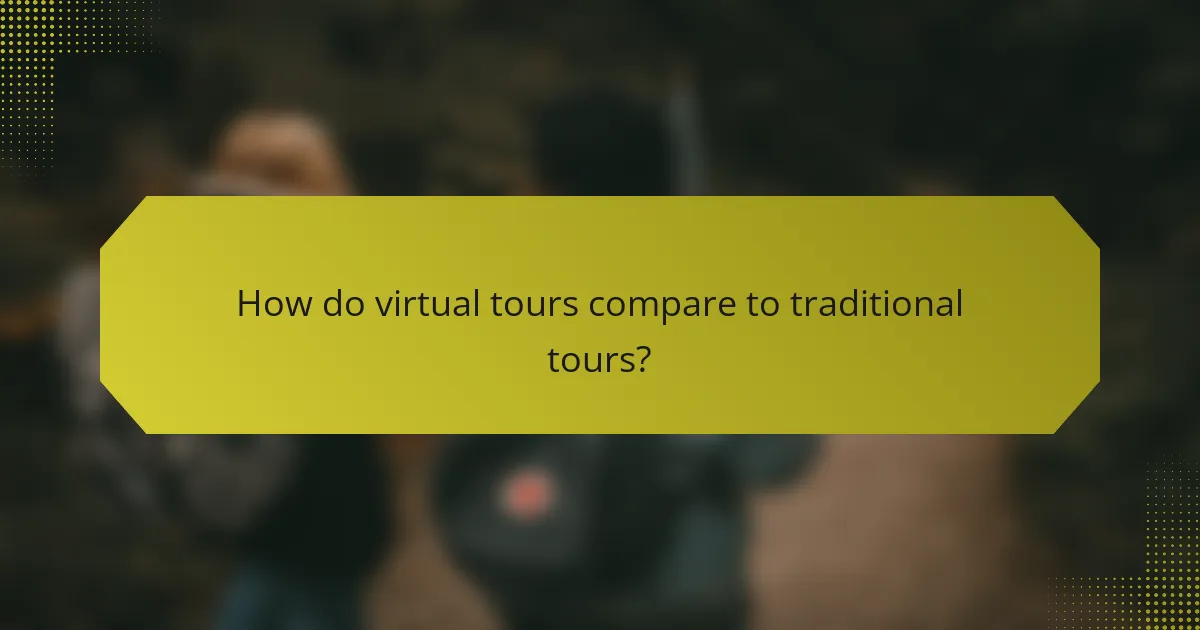
How do virtual tours compare to traditional tours?
Virtual tours offer a unique alternative to traditional tours by providing an immersive experience without the need for physical presence. While traditional tours rely on in-person interaction and exploration, virtual tours leverage technology to engage users from anywhere, making them accessible and convenient.
Effectiveness of Virtual Tours
Virtual tours can be highly effective in showcasing locations, especially for those unable to visit in person. They allow users to explore spaces at their own pace, often providing interactive elements that enhance understanding and retention. However, the effectiveness can vary based on the quality of the virtual experience and the technology used.
For instance, high-quality 360-degree videos or interactive maps can significantly improve user engagement compared to basic slideshow presentations. Organizations should consider investing in professional-grade virtual tour technology to maximize impact.
Engagement Levels
Engagement levels in virtual tours can be quite high due to interactive features such as clickable hotspots and embedded multimedia content. These elements keep users actively involved, often leading to longer viewing times compared to traditional tours, where attention may wane during lengthy presentations.
To boost engagement, consider incorporating quizzes or feedback options within the virtual tour. This not only makes the experience more interactive but also provides valuable insights into user preferences and interests.
Visitor Experience
The visitor experience in virtual tours can be tailored to individual preferences, allowing for a more personalized journey. Users can choose what to explore and when, which can enhance satisfaction compared to the fixed itinerary of traditional tours.
However, it’s essential to ensure that the virtual tour is user-friendly and accessible on various devices. A seamless experience across desktops, tablets, and smartphones can significantly enhance visitor satisfaction and encourage repeat engagement.
